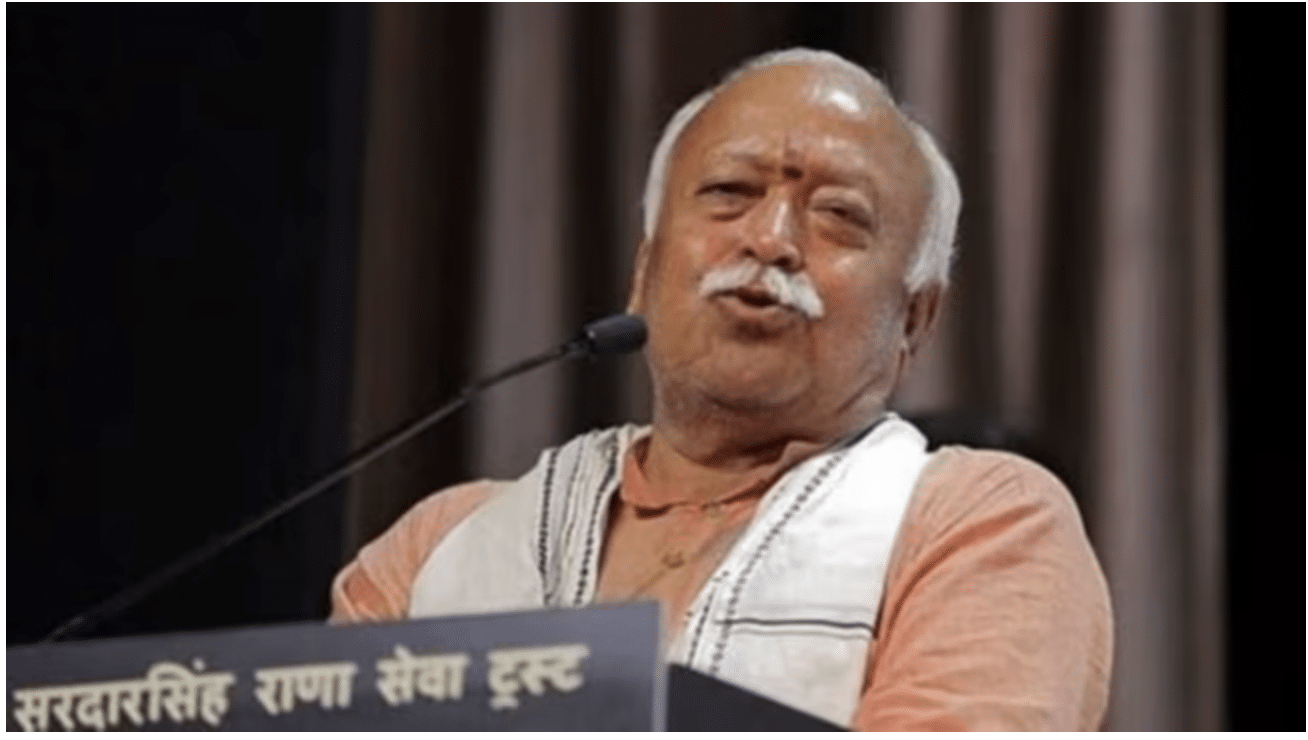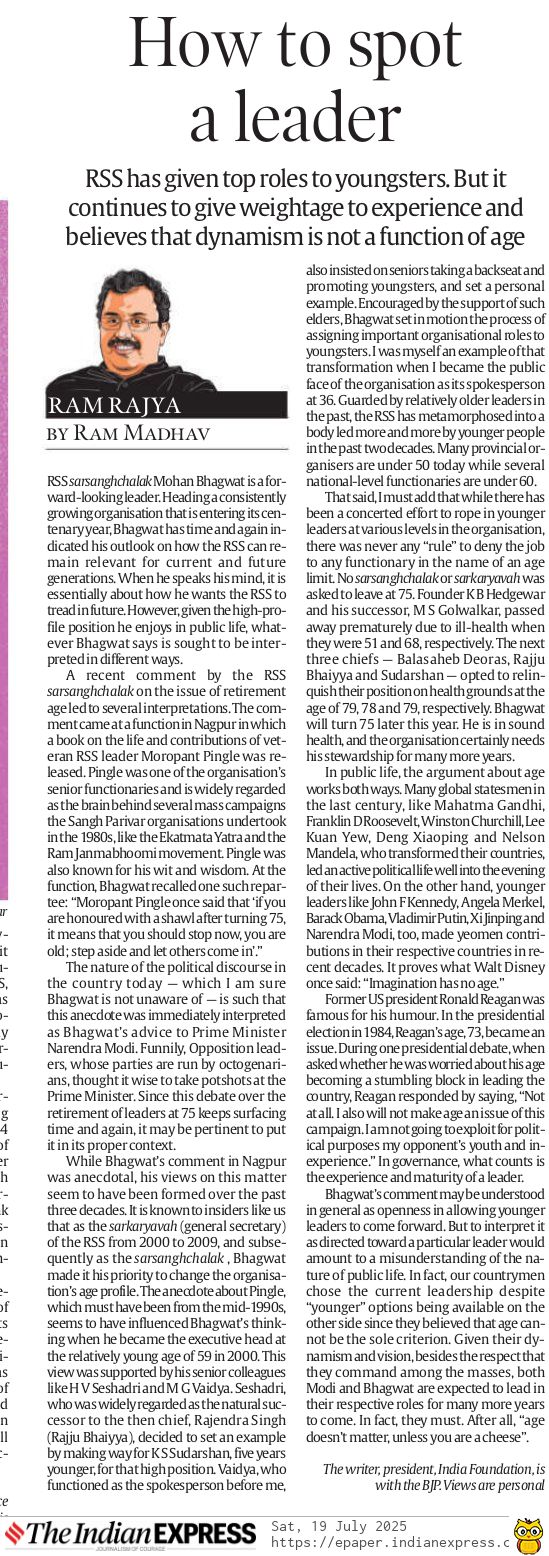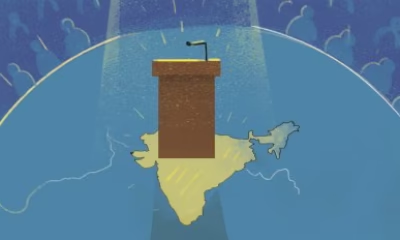
|
Getting your Trinity Audio player ready...
|
(The article was originally published in Indian Express on July 19, 2025 as a part of Dr Madhav’s column titled ‘Ram Rajya’. Views expressed are personal.)
RSS sarsanghchalak Mohan Bhagwat is a forward-looking leader. Heading a consistently growing organisation that is entering its centenary year, Bhagwat has time and again indicated his outlook on how the RSS can remain relevant for current and future generations. When he speaks his mind, it is essentially about how he wants the RSS to tread in future. However, given the high-profile position he enjoys in public life, whatever Bhagwat says is sought to be interpreted in different ways.
A recent comment by the RSS sarsanghchalak on the issue of retirement age led to several interpretations. The comment came at a function in Nagpur in which a book on the life and contributions of veteran RSS leader Moropant Pingle was released. Pingle was one of the organisation’s senior functionaries and is widely regarded as the brain behind several mass campaigns the Sangh Parivar organisations undertook in the 1980s, like the Ekatmata Yatra and the Ram Janmabhoomi movement. Pingle was also known for his wit and wisdom. At the function, Bhagwat recalled one such repartee: “Moropant Pingle once said that ‘if you are honoured with a shawl after turning 75, it means that you should stop now, you are old; step aside and let others come in’.”
The nature of the political discourse in the country today — which I am sure Bhagwat is not unaware of — is such that this anecdote was immediately interpreted as Bhagwat’s advice to Prime Minister Narendra Modi. Funnily, Opposition leaders, whose parties are run by octogenarians, thought it wise to take potshots at the Prime Minister. Since this debate over the retirement of leaders at 75 keeps surfacing time and again, it may be pertinent to put it in its proper context.
While Bhagwat’s comment in Nagpur was anecdotal, his views on this matter seem to have been formed over the past three decades. It is known to insiders like us that as the sarkaryavah (general secretary) of the RSS from 2000 to 2009, and subsequently as the sarsanghchalak , Bhagwat made it his priority to change the organisation’s age profile. The anecdote about Pingle, which must have been from the mid-1990s, seems to have influenced Bhagwat’s thinking when he became the executive head at the relatively young age of 49 in 2000. This view was supported by his senior colleagues like H V Seshadri and M G Vaidya. Seshadri, who was widely regarded as the natural successor to the then chief, Rajendra Singh (Rajju Bhaiyya), decided to set an example by making way for K S Sudarshan, five years younger, for that high position. Vaidya, who functioned as the spokesperson before me, also insisted on seniors taking a backseat and promoting youngsters, and set a personal example. Encouraged by the support of such elders, Bhagwat set in motion the process of assigning important organisational roles to youngsters. I was myself an example of that transformation when I became the public face of the organisation as its spokesperson at 36. Guarded by relatively older leaders in the past, the RSS has metamorphosed into a body led more and more by younger people in the past two decades. Many provincial organisers are under 50 today while several national-level functionaries are under 60.
That said, I must add that while there has been a concerted effort to rope in younger leaders at various levels in the organisation, there was never any “rule” to deny the job to any functionary in the name of an age limit. No sarsanghchalak or sarkaryavah was asked to leave at 75. Founder K B Hedgewar and his successor, M S Golwalkar, passed away prematurely due to ill-health when they were 51 and 68, respectively. The next three chiefs — Balasaheb Deoras, Rajju Bhaiyya and Sudarshan — opted to relinquish their position on health grounds at the age of 79, 78 and 79, respectively. Bhagwat will turn 75 later this year. He is in sound health, and the organisation certainly needs his stewardship for many more years.
In public life, the argument about age works both ways. Many global statesmen in the last century, like Mahatma Gandhi, Franklin D Roosevelt, Winston Churchill, Lee Kuan Yew, Deng Xiaoping and Nelson Mandela, who transformed their countries, led an active political life well into the evening of their lives. On the other hand, younger leaders like John F Kennedy, Angela Merkel, Barack Obama, Vladimir Putin, Xi Jinping and Narendra Modi, too, made yeomen contributions in their respective countries in recent decades. It proves what Walt Disney once said: “Imagination has no age.”
Former US president Ronald Reagan was famous for his humour. In the presidential election in 1984, Reagan’s age, 73, became an issue. During one presidential debate, when asked whether he was worried about his age becoming a stumbling block in leading the country, Reagan responded by saying, “Not at all. I also will not make age an issue of this campaign. I am not going to exploit for political purposes my opponent’s youth and inexperience.” In governance, what counts is the experience and maturity of a leader.
Bhagwat’s comment may be understood in general as openness in allowing younger leaders to come forward. But to interpret it as directed toward a particular leader would amount to a misunderstanding of the nature of public life. In fact, our countrymen chose the current leadership despite “younger” options being available on the other side since they believed that age cannot be the sole criterion. Given their dynamism and vision, besides the respect that they command among the masses, both Modi and Bhagwat are expected to lead in their respective roles for many more years to come. In fact, they must. After all, “age doesn’t matter, unless you are a cheese”.




